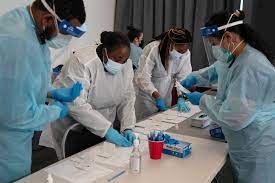Scientists are seeing signals that COVID-19 ′ s intimidating omicron surge may have peaked in Britain and is about to do the same in theU.S., at which point cases may start dropping off dramatically.
The reason The variant has proved so hectically contagious that it may formerly be running out of people to infect, just a month and a half after it was first detected in South Africa.
“ It’s going to come down as presto as it went up,” said Ali Mokdad, a professor of health criteria lores at the University of Washington in Seattle.
At the same time, experts advise that important is still uncertain about how the coming phase of the epidemic might unfold. The plateauing or declining in the two countries isn’t passing everyplace at the same time or at the same pace. And weeks or months of misery still lie ahead for cases and overwhelmed hospitals indeed if the drop-off comes to pass.
“ There are still a lot of people who’ll get infected as we descend the pitch on the backside,” said Lauren Ancel Meyers, director of the University of Texas COVID-19 Modeling Consortium, which predicts that reported cases will peak within the week.
The University of Washington’s own largely influential model systems that the number of diurnal reported cases in theU.S. will crest at1.2 million byJan. 19 and will also fall sprucely “ simply because everybody who could be infected will be infected,” according to Mokdad.
In fact, he said, by the university’s complex computations, the true number of new diurnal infections in theU.S. — an estimate that includes people who were noway tested — has formerly peaked, hitting 6 million onJan. 6.
In Britain, meanwhile, new COVID-19 cases dropped to about a day in the last week, after soaring to further than a day before this month, according to government data.
Kevin McConway, a sheltered professor of applied statistics at Britain’s Open University, said that while cases are still rising in places similar as southwest England and the West Midlands, the outbreak may have peaked in London.
The numbers have raised expedients that the two countries are about to suffer commodity analogous to what happed in South Africa, where in the span of about a month the surge crested at record highs and also fell significantly.
“ We’re seeing a definite falling-off of cases in theU.K., but I ’d like to see them fall much further before we know if what happed in South Africa will be then,” saidDr. Paul Hunter, a professor of drug at Britain’s University of East Anglia.
Differences between Britain and South Africa, including Britain’s aged population and the tendency of its people to spend further time indoors in the downtime, could mean a bumpier outbreak for the country and other nations like it.
On the other hand, British authorities’ decision to borrow minimum restrictions against omicron could enable the contagion to rip through the population and run its course important faster than it might in Western European countries that have assessed tougher COVID-19 controls, similar as France, Spain and Italy.
Shabir Mahdi, doyen of health lores at South Africa’s University of Witwatersrand, said European countries that put lockdowns will not inescapably come through the omicron surge with smaller infections; the cases may just be spread out over a longer period of time.
On Tuesday, the World Health Organization said there have been 7 million new COVID-19 cases across Europe in the once week, calling it a “ tidal surge sweeping across the region.” WHO cited modeling from Mokdad’s group that predicts half of Europe’s population will be infected with omicron within about eight weeks.
By that time, still, Hunter and others anticipate the world to be past the omicron swell.
“ There will presumably be some ups and campo along the way, but I would hope that by Easter, we will be out of this,” Hunter said.
Still, the sheer figures of people infected could prove inviting to fragile health systems, saidDr. Prabhat Jha of the Centre for Global Health Research atSt. Michael’s Sanitarium in Toronto.
“ The coming many weeks are going to be brutal because in absolute figures, there are so numerous people being infected that it’ll unmask over into ICUs,” Jha said.
Mokdad likewise advised in theU.S. “ It’s going to be a tough two or three weeks. We’ve to make hard opinions to let certain essential workers continue working, knowing they could be contagious.”
Omicron could one day be seen as a turning point in the epidemic, said Meyers, at the University of Texas. Impunity gained from all the new infections, along with new medicines and continued vaccination, could render the coronavirus commodity with which we can more fluently attend.
“ At the end of this surge, far further people will have been infected by some variant of COVID,” Meyers said. “ At some point, we ’ll be suitable to draw a line — and omicron may be that point — where we transition from what’s a disastrous global trouble to commodity that’s a much more manageable complaint.”
That is one presumptive future, she said, but there’s also the possibility of a new variant — bone that’s far worse than omicron — arising.

